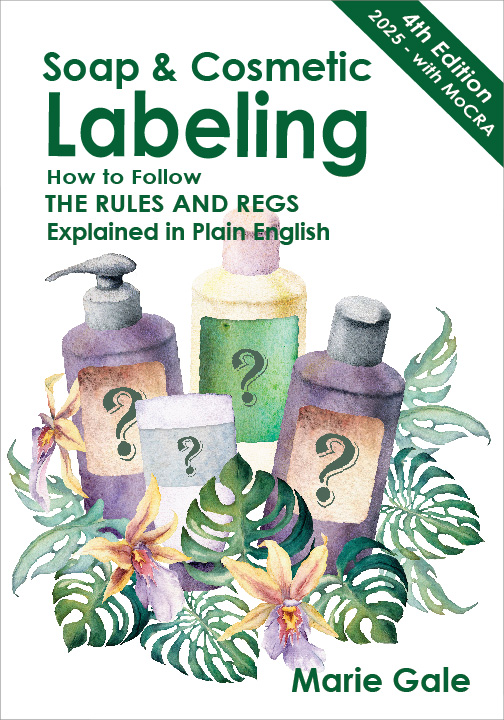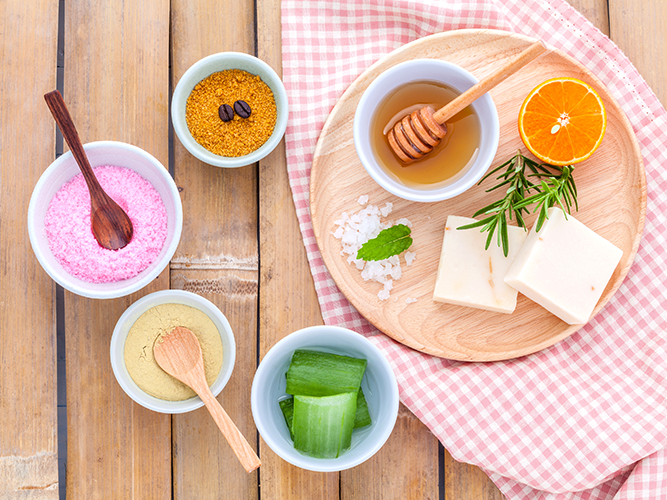When you make and label your own cosmetics, you are required to declare on the label all of the ingredients in descending order of predominance. In addition (and unlike food) you must list all of the components of any blended ingredient individually, in correct order in the ingredient declaration. If you purchase, for example, a preservative that has several component ingredients, they ALL must be listed in your ingredient declaration, in descending order of predominance in the whole. You can’t just say “preservative” or give the brand name or list the ingredients as “xxx (and) xxx (and) xxx.”
In a perfect world, every supplier would provide you with a list of all the component ingredients and their percentages. Wouldn’t that be wonderful! But, honestly, it’s not going to happen very often for a variety of reasons. Let’s take a look at some of the possibilities and how you can deal with them.
You purchased a retail product from a store
Many of the ingredients we use in handcrafted soap and cosmetics can be purchased from a grocery store. If it’s a food or a cosmetic, it must have the ingredients declared on the label, which is a good place to start.
Example: Coconut or Olive Oil
Oils are pretty easy because they are single ingredients. You don’t need to know anything other than what it is. When your formulation calls for 50% coconut oil, you know that it goes in the ingredient declaration first (nothing else will be present at more than 50%). If you use 30% coconut oil, it goes after anything present at 31% or more and before anything present at 29% or less.
Example: Sugar Sprinkles for Bath Fizzies
Sugar sprinkles are a food, so all of the ingredients will be listed on the package. Because it’s food, some of the ingredients may be blended listings, e.g. “Chocolate (cocoa and sugar).” None of the percentages will be disclosed (and aren’t required to be). What to do then?
Sugar sprinkles are unlikely to be a large percentage of the total of your finished product. If they are present at 1% (or maybe just a bit more), it means that everything in the sprinkles is present at 1% or less. So that means all the component ingredients can be listed in any order after the ingredients present at more than 1%. It may take up more room than you’d like on the label, but it’s not hard to do.
The cosmetic labeling regulations include a provision for “incidental ingredients,” which don’t need to be listed. The first definition of an incidental ingredient is the one that could apply:
Directly from the regulations:
(1)Substances that have no technical or functional effect in the cosmetic but are present by reason of having been incorporated into the cosmetic as an ingredient of another cosmetic ingredient.
21CFR701.3(l)(1)
In this example, the component ingredients of the sugar sprinkles that are NOT non-functional (they do play a role in the finished product) would include the sugar (which you wouldn’t need to list if you already had sugar listed in the ingredient declaration), whatever holds them together as sprinkles (probably cornstarch and some sort of liquid/oil) and the colors. Any flavor is non-functional, and any preservative is non-functional. It gives you a place to start.
Example: Aloe Vera Gel
Aloe Vera Gel is a cosmetic. Typically it’s made of aloe vera, and sometimes alcohol, carbomer (to thicken), preservative, color additive, and maybe other ingredients. Will the manufacturer provide you with the percentages of the ingredients? Unlikely. How they make their product is their special secret and they probably won’t be inclined to share it with you.
If you decide to use a blended cosmetic as an ingredient in your cosmetic or soap, you will need to look long and hard at the ingredient declaration to see if you can figure out how to correctly add all the components to your product’s ingredient declaration. If you can’t make a definitive determination, perhaps you should reformulate with a different ingredient.
You purchased a cosmetic ingredient from a supplier
A cosmetic ingredient that is going to be used in the manufacture of another product is not a “consumer commodity.” It isn’t going to be used by a consumer, it’s going to be used in manufacturing. That means that the requirements for an ingredient declaration don’t apply. Whaaat? That’s right—the supplier doesn’t HAVE to provide you with the component ingredients. However, they know that you need to have sufficient detail to meet your legal labeling obligations, so they do provide some, hopefully enough, information.
Example: Full List with Percentages
Some cosmetic ingredients have been around for long enough that the formulations are well known, or the manufacturer has decided to provide the exact percentages of the component ingredients. In that case, you are likely to be provided with the exact percentages of the component ingredients. It doesn’t happen often, but when it does it makes creating your ingredient declaration much easier!
Example: Help Placing Additives in the List
When you purchase a premade base, such as a lotion base or a melt & pour soap, the supplier will typically provide a detailed ingredient declaration that you can use. The trick then, is where to place any additives you put in the base (color, scent, herbals, etc.) in the ingredient declaration. There a couple of different ways this can play out.
Sometimes the supplier will say, “Use x% to x% fragrance and put it between this ingredient and that ingredient in the ingredient declaration”. You don’t know how much of “this” ingredient and “that” ingredient is actually in the base, but you know where to put your fragrance in the list.
Sometimes the supplier will say, “Don’t add more than 1% of anything, and put it all at the end.” That works since the ingredients present at 1% or less can go in any order after the ingredients present at more than 1%.
If you go outside the general parameters provided by the supplier, then you need more information in order to meet your legal labeling obligations. Call the supplier. If they have good customer service, you can tell them what you’re adding and they’ll tell you how to place it in the ingredient declaration. If their customer service is not so good, and you can’t figure out how to list your ingredients … maybe consider a different supplier next time.
Example: A Proprietary Ingredient
Many cosmetic ingredients are proprietary formulations. The ingredient manufacturer wants you to buy their product to use in your formulation, but they don’t really want to tell you how they make their “secret sauce.” They also know you won’t buy it if you can’t figure out how to legally label your product. So, the manufacturers have a couple of ways to get you the information you need.
One way is by having you tell them what your formulation is, and then they tell you where to place the component ingredients. You end up knowing how to list all the ingredients, but they don’t tell you what the exact percentages are in their secret sauce.
The other way is for you to sign a non-disclosure agreement, and then they provide the exact percentages of the components in their secret sauce. Usually this happens with large suppliers providing a unique ingredient to a large manufacturer, but it sometimes is used when selling to smaller companies.
Whichever way it goes, you either don’t know or can’t say what the percentages are in the secret sauce, so they feel their secret is safe with you.
Example: Partial or Questionable Disclosure
Sometimes you get a list of components that appears to be partial or questionable—you just aren’t sure that you have all the correct information. This is one of those times when you need to follow your gut instinct.
It is up to you to decide if you have enough information to make an accurate ingredient declaration. If you don’t have enough information to feel comfortable with your ingredient declaration, and you can’t seem to get the data you need, then you need to step back and decide whether or not you want to use that ingredient in your product.
The Buck Stops With You
Be savvy. Get the information you need from your supplier or the product manufacturer so you can create accurate ingredient declarations you are certain of. If you can’t get enough detail to be certain you are correctly listing the ingredients in your ingredient declaration, consider reformulating with different ingredients and/or finding a different supplier.
If the FDA ever (heaven forbid) comes knocking on your door and checking your products, it doesn’t matter what your supplier told you—if the ingredient declaration on your product label doesn’t match the reality of what’s actually in the product, the buck stops with you.

Shameless plug!
To really be able to create your own labels that comply with the regulations, get my book from Amazon and use it.
4th Edition – Released March 5, 2025!!!
Or order directly from me (and get a signed copy)!


Leave a Reply